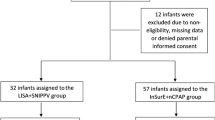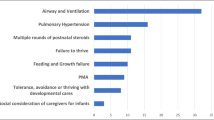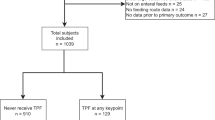Abstract
Background
To identify the evidence for administering positive pressure ventilation (PPV) to infants at birth by either T-piece resuscitator (TPR) or self-inflating bag (SIB), and to determine whether a full systematic review (SR) is warranted.
Methods
Guided by the Preferred Reporting Items for Systematic reviews and Meta-Analyses extension for scoping reviews, eligible studies included peer-reviewed human studies, prospectively or retrospectively comparing a TPR vs. SIB for administering PPV at birth. Databases searched were OVID Medline, PubMed, Embase and the Cochrane Central Register of Controlled Trials. Review Manager software was used for the data analysis.
Results
Following electronic literature search and review, data from four eligible studies (3 RCT and 1 observational study), enrolling a total of 2889 patients, were included. Studies differed regarding the investigated populations, reported outcomes and came from different geographical areas. In particular for preterm infants, use of TPR for providing PPV may improve survival, result in fewer intubations at birth and decrease the incidence of bronchopulmonary dysplasia.
Conclusions
This scoping review identified two new studies with substantive new evidence, pointing towards improved survival, decreased bronchopulmonary dysplasia and fewer intubations at birth, in particular among preterm infants treated with TPR. Full SR of the literature is advised.
Impact
-
This scoping review identified studies comparing TPR vs. SIB for respiratory support of newborn infants previously not included in the International Liaison Committee on Resuscitation (ILCOR) recommendations.
-
Our review found substantive new evidence highlighting that device choice may impact the outcomes of compromised newborn infants’.
-
This scoping review stipulates the need for full SR and updated meta-analysis of studies investigating supportive equipment for stabilizing infants at birth in order to inform ILCOR treatment recommendations.
Similar content being viewed by others
Log in or create a free account to read this content
Gain free access to this article, as well as selected content from this journal and more on nature.com
or
References
Vento, M. & Saugstadt, O. D. Resuscitation of the term and preterm infant. Semin. Fet Neonat. Med. 15, 216–222 (2010).
Weiner, G. M., Zaichkin, J., Kattwinkel, J. & Ades A. in Textbook of neonatal resuscitation 7th edn (eds Weiner, G. M., Zaichkin, J., Kattwinkel, J. & Ades, A.) (Elk GroveVillage, 2016).
Björklund, L. J. et al. Manual ventilation with a few large breaths at birth compromises the therapeutic effect of subsequent surfactant replacement in immature lambs. Pediatr. Res. 42, 348–55 (1997).
Jobe, A. H. & Ikegami, M. Mechanisms initiating lung injury in the preterm. Early Hum. Dev. 53, 81–94 (1998).
Jobe, A. H. Mechanisms of lung injury and bronchopulmonary dysplasia. Am. J. Perinatol. 33, 1076–8 (2016).
Perlman, J. M. et al. Part 7: Neonatal Resuscitation: 2015 International Consensus on Cardiopulmonary Resuscitation and Emergency Cardiovascular Care Science With Treatment Recommendations. Circulation 132(Suppl. 1), S204–41 (2015).
Wyllie, J. et al. European Resuscitation Council Guidelines for Resuscitation 2015: Section 7. Resuscitation and support of transition of babies at birth. Resuscitation 95, 249–63 (2015).
Escobedo, M. B. et al. 2019 American Heart Association Focused Update on Neonatal Resuscitation: an update to the American Heart Association Guidelines for Cardiopulmonary Resuscitation and Emergency Cardiovascular Care. Circulation 10, e922–e930 (2019).
Resuscitation Council UK. Newborn Life Support 4th edn, ISBN: 9781 903812 33 4 (2016).
Roehr, C. C., O’Shea, J. E., Dawson, J. A. & Wyllie, J. P. Devices used for stabilisation of newborn infants at birth. Arch. Dis. Child Fetal Neonatal Ed. 103, F66–F71 (2018).
O’Donnell, C. P., Davis, P. G. & Morley, C. J. Positive pressure ventilation at neonatal resuscitation: review of equipment and international survey of practice. Acta Paediatr. 93, 583–8 (2004).
O’Donnell, C. P., Davis, P. G. & Morley, C. J. Use of supplementary equipment for resuscitation of newborn infants at tertiary perinatal centres in Australia and New Zealand. Acta Paediatr. 94, 1261–5 (2005).
Iriondo, M. et al. A survey of neonatal resuscitation in Spain: gaps between guidelines and practice. Acta Paediatr. 98, 786–91 (2009).
Roehr, C. C. et al. Delivery room management of very low birth weight infants in Germany, Austria and Switzerland—a comparison of protocols. Eur. J. Med. Res. 15, 493–503 (2010).
Trevisanuto, D. et al. Changes over time in delivery room management of extremely low birth weight infants in Italy. Resuscitation 85, 1072–6 (2014).
Trevisanuto, D. et al. Delivery room management of extremely low birthweight infants shows marked geographical variations in Italy. Acta Paediatr. 103, 605–11 (2014).
Charles, E., Hunt, K., Murthy, V., Harris, C. & Greenough, A. UK neonatal resuscitation survey. Arch. Dis. Child Fetal Neonatal Ed. 104, F324–F325 (2019).
Hooper, S. B., Siew, M. L., Kitchen, M. J. & te Pas, A. B. Establishing functional residual capacity in the non-breathing infant. Semin. Fetal Neonatal Med. 18, 336–43 (2013).
Siew, M. L. et al. Positive end-expiratory pressure enhances development of a functional residual capacity in preterm rabbits ventilated from birth. J. Appl. Physiol. 2009, 1487–93 (1985).
Martherus, T. et al. Supporting breathing of preterm infants at birth: a narrative review. Arch. Dis. Child Fetal Neonatal Ed. 104, F102–F107 (2019).
Hawkes, C. P., Ryan, C. A. & Dempsey, E. M. Comparison of the T-piece resuscitator with other neonatal manual ventilation devices: a qualitative review. Resuscitation 83, 797–802 (2012).
Finer, N. N., Rich, W., Craft, A. & Henderson, C. Comparison of methods of bag and mask ventilation for neonatal resuscitation. Resuscitation 49, 299–305 (2001).
Bennett, S., Finer, N. N., Rich, W. & Vaucher, Y. A comparison of three neonatal resuscitation devices. Resuscitation 67, 113–8 (2005).
Tracy, M. B., Halliday, R., Tracy, S. K. & Hinder, M. K. Newborn self-inflating manual resuscitators: precision robotic testing of safety and reliability. Arch. Dis. Child Fetal Neonatal Ed. 104, F403–F408 (2019).
Hinder, M., McEwan, A., Drevhammer, T., Donaldson, S. & Tracy, M. B. T-piece resuscitators: how do they compare? Arch. Dis. Child Fetal Neonatal Ed. 104, F122–F127 (2019).
Roehr, C. C. et al. Manual ventilation devices in neonatal resuscitation: tidal volume and positive pressure-provision. Resuscitation 81, 202–5 (2010).
Kelm, M., Proquitté, H., Schmalisch, G. & Roehr, C. C. Reliability of two common PEEP-generating devices used in neonatal resuscitation. Klin. Padiatr. 221, 415–8 (2009).
Thio, M. et al. Delivery of positive end-expiratory pressure to preterm lambs using common resuscitation devices. Arch. Dis. Child Fetal Neonatal Ed. 104, F83–F88 (2019).
Rafferty, A. R. et al. The accuracy of delivery of target pressures using self-inflating bag manometers in a benchtop study. Acta Paediatr. 105, e247–51 (2016).
Hartung, J. C. et al. Time to adjust to changes in ventilation settings varies significantly between different T-piece resuscitators, self-inflating bags, and manometer equipped self-inflating bags. Am. J. Perinatol. 31, 505–12 (2014).
Dawson, J. A. et al. Oxygenation with T-piece versus self-inflating bag for ventilation of extremely preterm infants at birth: a randomized controlled trial. J. Pediatr. 158, 912–918 (2011).
Szyld, E. et al. Delivery Room Ventilation Devices Trial Group. Comparison of devices for newborn ventilation in the delivery room. J. Pediatr. 165, 234–239 (2014).
Arksey, H. & O’Malley, L. Scoping studies: towards a methodological framework. Int. J. Soc. Res. Methodol. 8, 19–32 (2005).
Munn, Z., Stern, C., Aromataris, E., Lockwood, C. & Jordan, Z. What kind of systematic review should I conduct? A proposed typology and guidance for systematic reviewers in in the medical and health sciences. BMC Med. Res. Methodol. 18, 5 (2018).
Guinsburg, R. et al. T-piece versus self-inflating bag ventilation in preterm neonates at birth. Arch. Dis. Child Fetal Neonatal Ed. 103, F49–F55 (2018).
Thakur, A. et al. T-piece or self inflating bag for positive pressure ventilation during delivery room resuscitation: an RCT. Resuscitation 90, 21–4 (2015).
Tricco, A. C. et al. PRISMA Extension for Scoping Reviews (PRISMA-ScR): checklist and explanation. Ann. Intern. Med. 169, 467–473 (2018).
Puhan, M. A. et al. A GRADE Working Group approach for rating the quality of treatment effect estimates from network meta-analysis. BMJ 349, g5630 (2014).
Considine, J. et al. Chest compression components (rate, depth, chest wall recoil and leaning): a scoping review. Resuscitation 146, 188–202 (2020).
Acknowledgements
We acknowledge the expert assistance of Liz Callow, Outreach Librarian for Acute General Medicine, Paediatrics, Women’s Centre, Allied Health Professionals, and Pharmacy, Bodleian Health Care Libraries, Cairns Library, John Radcliffe Hospital, Oxford OX3 9DU, UK. The authors are further grateful to the International Liaison Committee on Resuscitation (ILCOR) for commissioning, and for the assistance in coordinating, this review. None of the authors received funding for their work on the manuscript.
Author information
Authors and Affiliations
Contributions
C.C.R. and D.T. planned and coordinated the literature review, both independently assessed and graded the literature. D.T. performed the data analysis. C.C.R. and D.T. drafted the initial manuscript. P.G.D. and G.M.W. provided input in the data analysis and gave expert opinion on the interpretation of the findings. J.W.J. and M.H.W. led the consensus process (ILCOR), which led to the formulation of the research question and commission of the scoping review. All authors contributed to the final completion of the manuscript.
Corresponding author
Ethics declarations
Competing interests
The authors declare no competing interests.
Additional information
Publisher’s note Springer Nature remains neutral with regard to jurisdictional claims in published maps and institutional affiliations.
Supplementary information
Rights and permissions
About this article
Cite this article
Roehr, C.C., Davis, P.G., Weiner, G.M. et al. T-piece resuscitator or self-inflating bag during neonatal resuscitation: a scoping review. Pediatr Res 89, 760–766 (2021). https://doi.org/10.1038/s41390-020-1005-4
Received:
Revised:
Accepted:
Published:
Issue date:
DOI: https://doi.org/10.1038/s41390-020-1005-4
This article is cited by
-
Comparison of Efficacy of Pressure Controlled vs. Traditional Manual Mask Ventilation for Newborn Resuscitation – A Simulation-Based Pilot Randomized Control Trial
Indian Journal of Pediatrics (2024)
-
Versorgung und Reanimation des Neugeborenen nach der Geburt
Notfall + Rettungsmedizin (2021)



